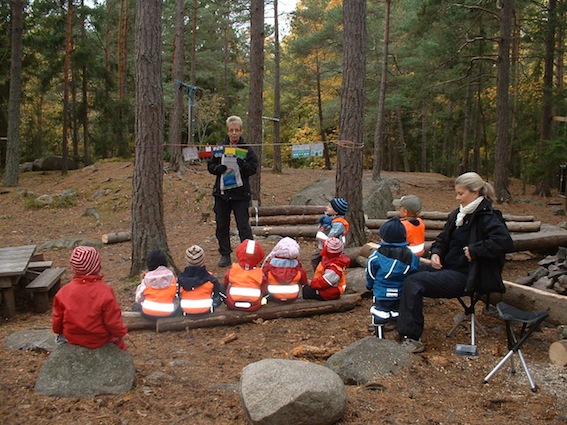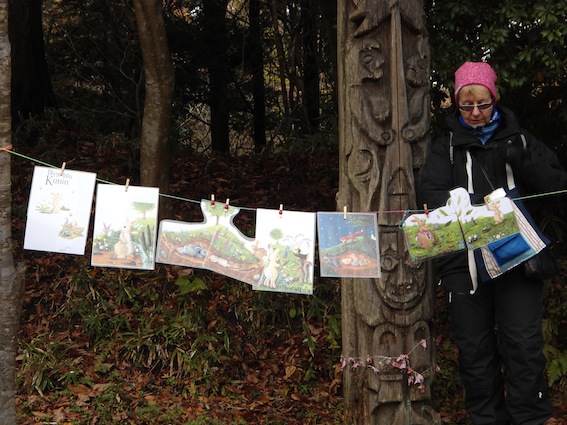Back in 2008 my first introduction to a Swedish outdoor “Rain or Shine” nursery was Skogsnattarna I Ur och Skur. At the first gathering session, I met Anna, one of the teachers, who used a story line outside. This was part of the routine in this nursery.

Using a washing line works well for this sort of activity. Stretchy camping ones or karabiner bungee cord make this activity portable and quick to set up in a range of different places – trees, fence s, etc. The time consuming part is developing enough stories which can be used this way. Anna has a little bag which she uses that contains the washing line, pegs and cards needed. You can see her wearing it in the above photo.
If you notice, her story line is fixed above the children’s heads as this allows the children to see the story, even if a child jumps up for a closer look or discussion. For children to be involved in pegging up the cards, you may wish to have a lower line. In this situation using brightly coloured cord can be helpful so that it is visible to all even on darker days.
In the photo above, the cards were all home made. There are several advantages to this approach:
- You can mix and match stories and so can the children
- You are not following a fixed story line so it allows for spontaneity. In the photo, the child standing up, was very interested in actively participating. As a consequence the Swedish equivalent of “Five Little Monkeys” ended up being incorporated into the story.
- There is less risk of you getting all the cards muddled up and in the wrong order.
- You can have as many or as few cards as needed.
In the photo below, which was taken in Japan, Anna had brought along a story book which had been taken apart and laminated. This sounds straightforward but it isn’t as most stories have illustrations and text on both sides. Some books, such as Slinky Malinky and others in the Lynley Dodd series just have an illustration on one side and text on the other. I’ve found this much easier.

Anna told me that she likes using a story line because children can see the story unfold before their eyes. Each card is pegged up one at a time. With a story book, when the page is turned, the illustration of the previous pages are hidden. On a story line, the children can easily look back and see the plot develop using the cards as a visual cue.
For older and more able children, the story line approach is still a useful reading activity outside. Various games can be developed to reinforce the sequence or the plot of a story or poem. For example:
- Children can hide parts of the story for others to find and bring back to the line. Everyone helps sequence the story.
- Children can take turns to remove a card whilst others close their eyes. Then the group has to work out which card is missing.
- The cards can be muddled up and children have to sort them out.
From my own experiences of cutting up and using books, I would also consider the following:
- Number each page. Otherwise you will struggle to find the order.
- Be judicious about the number of pages. I shorten books so that only the key text and illustrations are given. For example Where the Wild Things Are has 24 pages, which I have narrowed down to 10. This is more manageable.
- Go for second hand books and buy three copies to allow you to make mistakes and get a good sequence.
- Remember never to photocopy books. It’s not okay.
- For alternatives to laminating a book, have a look at this blog post. I use ziplock bags which work well.
I’m sure you will have used a story line at some point in your work with children. If so, I would be interested to know your experiences and advice on the matter.
Finally, in case anyone is confused, there is an official “Storyline” approach which has nothing to do with washing lines but is a great approach to project work. Have a look at Storyline Scotland for more information.
This blog post was first posted in September 2013.




















What a great idea, thanks so much for sharing. Now I know what to do with all those extra copies of certain books I have….
Yes! If you have more than one copy then you are fine 🙂
I have never even heard of this idea. Outdoor literacy made easy and portable. I especially like the idea of mixing and matching stories. I can see some children really getting into it. A teacher could also offer blank sheets for the children to fill in using their imagination. This can easily be done inside, too.
Hello Tom
I really like that suggestion of blank sheets too – just adds to the whole story creating excitement. I can also picture this all hanging above a water table in your classroom!
Best wishes
Juliet
Thanks for linking up 🙂